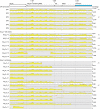Spontaneous reactivation of latent HIV-1 promoters is linked to the cell cycle as revealed by a genetic-insulators-containing dual-fluorescence HIV-1-based vector
- PMID: 29977044
- PMCID: PMC6033903
- DOI: 10.1038/s41598-018-28161-y
Spontaneous reactivation of latent HIV-1 promoters is linked to the cell cycle as revealed by a genetic-insulators-containing dual-fluorescence HIV-1-based vector
Abstract
Long-lived latently HIV-1-infected cells represent a barrier to cure. We developed a dual-fluorescence HIV-1-based vector containing a pair of genetic insulators flanking a constitutive fluorescent reporter gene to study HIV-1 latency. The protective effects of these genetic insulators are demonstrated through long-term (up to 394 days) stable fluorescence profiles in transduced SUP-T1 cells. Analysis of 1,941 vector integration sites confirmed reproduction of HIV-1 integration patterns. We sorted monoclonal cells representing latent HIV-1 infections and found that both vector integration sites and integrity of the vector genomes influence the reactivation potentials of latent HIV-1 promoters. Interestingly, some latent monoclonal cells exhibited a small cell subpopulation with a spontaneously reactivated HIV-1 promoter. Higher expression levels of genes involved in cell cycle progression are observed in these cell subpopulations compared to their counterparts with HIV-1 promoters that remained latent. Consistently, larger fractions of spontaneously reactivated cells are in the S and G2 phases of the cell cycle. Furthermore, genistein and nocodazole treatments of these cell clones, which halted cells in the G2 phase, resulted in a 1.4-2.9-fold increase in spontaneous reactivation. Taken together, our HIV-1 latency model reveals that the spontaneous reactivation of latent HIV-1 promoters is linked to the cell cycle.
Conflict of interest statement
K.J.M. has received travel grants and honoraria from Gilead Sciences, Roche Diagnostics, Tibotec, Bristol-Myers Squibb, and Abbott; the University of Zurich has received research grants from Gilead, Roche, and Merck Sharp & Dohme for studies that K.J.M. serves as principal investigator, and advisory board honoraria from Gilead Sciences. All other authors declare no competing interests.
Figures







Similar articles
-
HIV Provirus Stably Reproduces Parental Latent and Induced Transcription Phenotypes Regardless of the Chromosomal Integration Site.J Virol. 2016 May 12;90(11):5302-14. doi: 10.1128/JVI.02842-15. Print 2016 Jun 1. J Virol. 2016. PMID: 26984732 Free PMC article.
-
Designed transcription activator-like effector proteins efficiently induced the expression of latent HIV-1 in latently infected cells.AIDS Res Hum Retroviruses. 2015 Jan;31(1):98-106. doi: 10.1089/AID.2014.0121. AIDS Res Hum Retroviruses. 2015. PMID: 25403229 Free PMC article.
-
RNA-induced epigenetic silencing inhibits HIV-1 reactivation from latency.Retrovirology. 2018 Oct 4;15(1):67. doi: 10.1186/s12977-018-0451-0. Retrovirology. 2018. PMID: 30286764 Free PMC article.
-
Underlying mechanisms of HIV-1 latency.Virus Genes. 2017 Jun;53(3):329-339. doi: 10.1007/s11262-017-1443-1. Epub 2017 Mar 3. Virus Genes. 2017. PMID: 28258391 Review.
-
Molecular mechanisms involved in HIV-1 transcriptional latency and reactivation: implications for the development of therapeutic strategies.Bull Mem Acad R Med Belg. 2004;159(Pt 2):176-89. Bull Mem Acad R Med Belg. 2004. PMID: 15615091 Review.
Cited by
-
HIV-1 promoter is gradually silenced when integrated into BACH2 in Jurkat T-cells.PeerJ. 2020 Nov 24;8:e10321. doi: 10.7717/peerj.10321. eCollection 2020. PeerJ. 2020. PMID: 33282555 Free PMC article.
-
Cat and Mouse: HIV Transcription in Latency, Immune Evasion and Cure/Remission Strategies.Viruses. 2019 Mar 18;11(3):269. doi: 10.3390/v11030269. Viruses. 2019. PMID: 30889861 Free PMC article. Review.
-
Stable integrant-specific differences in bimodal HIV-1 expression patterns revealed by high-throughput analysis.PLoS Pathog. 2019 Oct 4;15(10):e1007903. doi: 10.1371/journal.ppat.1007903. eCollection 2019 Oct. PLoS Pathog. 2019. PMID: 31584995 Free PMC article.
-
Quantification of transgene expression in GSH AAVS1 with a novel CRISPR/Cas9-based approach reveals high transcriptional variation.Mol Ther Methods Clin Dev. 2022 Jun 9;26:107-118. doi: 10.1016/j.omtm.2022.06.003. eCollection 2022 Sep 8. Mol Ther Methods Clin Dev. 2022. PMID: 35795775 Free PMC article.
-
Mycobacterium tuberculosis Reactivates HIV-1 via Exosome-Mediated Resetting of Cellular Redox Potential and Bioenergetics.mBio. 2020 Mar 3;11(2):e03293-19. doi: 10.1128/mBio.03293-19. mBio. 2020. PMID: 32127457 Free PMC article.
References
Publication types
MeSH terms
Substances
Grants and funding
LinkOut - more resources
Full Text Sources
Other Literature Sources
Medical
Research Materials

